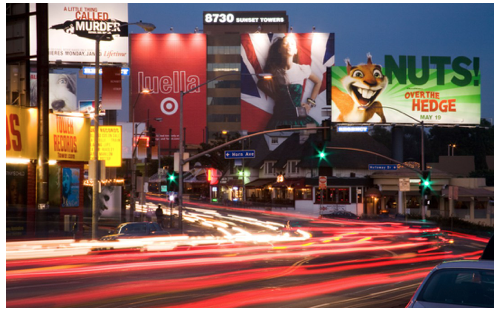CommentsBILLBOARD BLIGHT-There will be hundreds of new digital billboards all across the city, flashing ad messages that change every eight seconds all day and into the night, if the City Council Planning and Land Use Management (PLUM) Committee gets its way. The new draft legislation they unveiled at a Dec. 12 City Hall hearing basically capitulates to the sign companies, generally ignoring traffic safety, aesthetics and environmental concerns.
Simply put, the draft legislation will allow new digital billboards on almost any property with the word “commercial” in its zoning. Digital signage could consist of on-site signs which promote the businesses where they are located, or off-site signs, commonly known as billboards, which promote things like movies, consumer products, personal injury attorneys and gentlemen’s clubs. The loose language of this bill will open up hundreds of business properties, intersections, and strip malls to new illuminated signage. Such signs are in addition to the Tier 1 Sign Districts that the new legislation also creates, in the most intensely commercial zones such as along parts of Sunset Boulevard and near LA Live.
Get ready for digital billboards just about anywhere the sign companies would like to put them.
The chair of the PLUM committee, Councilmember José Huizar, often points out that the new legislation will include provisions to reduce billboard blight. This will supposedly be accomplished through (1) taking down existing static signs to earn the right to establish new digitals, and (2) payments by sign companies to a fund that would enable some street-level improvements such as sidewalk widening and tree planting. However, the takedown ratio is as low as 2:1 (two static billboards taken down in exchange for one new digital), the payments are both low and voluntary, and the improvements should be done by the city anyway. The bill will likely achieve a reduction in the total number of billboards in the city; but this will come at the cost of literally hundreds of new digital signs.
Other provisions in the bill also show the clear hand of sign companies. For example, it allows for “adjustments” and “variances” so that a sign company could ask to bend the rules and make any sign up to 20 percent larger or higher than law otherwise would allow. This idea was never raised in any public hearing on this legislation, and it would continue the lax, “pay-to-play” permitting environment that has plagued LA for decades.
The new legislation basically blows open a version submitted to PLUM in 2015 by the City Planning Commission. The earlier bill, known as Version B+, allowed new digital signs (only off-site, not on-site) only in Tier 1 zones, and only in exchange for a 10:1 takedown ratio.
The sign companies have donated free billboard space to most members of the PLUM Committee; in the case of Chair Huizar, 100 of them. That’s what’s driving this bill: money, and the fear that those free billboards might go to their opponents in the next election.
Numerous studies have shown that digital signs contribute to driver distraction which causes accidents; that's why they need to be closely regulated. Instead of regulation, however, this bill gives us capitulation. Because the hearing process is not yet complete, the bill (Council File 11-1705) may still evolve further. But what's on the table right now is not appetizing in the least.
(Patrick Frank is President of the Coalition to Ban Billboard Blight.)
-cw
















